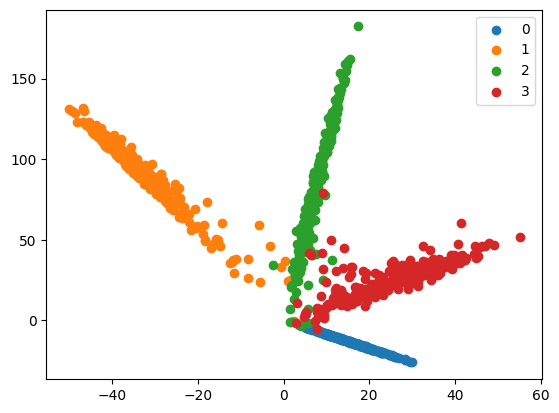from torch import nn
from fastai_datasets.all import *
from similarity_learning.utils import *
from similarity_learning.siamese import *
from similarity_learning.pair_matching import *Plotting Feature Space
Visualizing low-dimensional feature spaces
Since the backbone (in charge of embedding in feature space) plays such an intergral role in similarity learning, it’s natural that we’d want to examine it. While it’s usually too high-dimensional to plot directly, we could force it to be low-dimensional for the purpose of plotting.
plot_dataset_embedding
plot_dataset_embedding (dataset:fastai.data.core.Datasets, feature_extractor, num_samples_per_class=300, normalize_features=False, *args, **kwargs)
In order to properly classify using only 3 features, we should pick a relatively simple dataset. Let’s use MNIST:
mnist = MNIST()
mnist = mnist.by_target['0'] + mnist.by_target['1'] + mnist.by_target['2'] + mnist.by_target['3']
100.00% [10/10 00:00<00:00]
learn = Learner(mnist.dls(), MLP(10, features_dim=2), metrics=accuracy)
learn.fit(1)| epoch | train_loss | valid_loss | accuracy | time |
|---|---|---|---|---|
| 0 | 0.097074 | 0.062883 | 0.982680 | 00:11 |
plot_dataset_embedding(mnist, cut_model_by_name(learn.model, 'hidden_layers'))
100.00% [4/4 00:00<00:00]

Compare with training a ThresholdSiamese and extracting the backbone:
learn = Learner(Pairs(mnist, 1).dls(), ThresholdSiamese(MLP(None, features_dim=2)), metrics=accuracy)
learn.fit(1)| epoch | train_loss | valid_loss | accuracy | time |
|---|---|---|---|---|
| 0 | 0.314940 | 0.277123 | 0.966314 | 00:24 |
plot_dataset_embedding(mnist, learn.model.distance.backbone)
And with training a backbone with ContrastiveLoss
learn = Learner(Pairs(mnist, 1).dls(), DistanceSiamese(MLP(None, features_dim=2)), ContrastiveLoss())
learn.fit(1)| epoch | train_loss | valid_loss | time |
|---|---|---|---|
| 0 | 0.048055 | 0.039739 | 00:25 |
plot_dataset_embedding(mnist, learn.model.backbone)